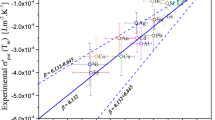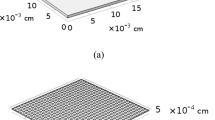Abstract
The interactions of liquid metals and alloys with the environment mostly depends on the thermodynamic properties of the liquid surface. In fact, the surface tension is strongly influenced by the presence in the surrounding atmosphere of reactive gases through solution, adsorption mechanisms and/or surface reactions. In particular, oxygen, which shows a high surface activity towards a large number of metallic systems, is the most important contaminant of liquid metals and alloys.
Theoretical approaches for estimating the oxygen mass transfer at the liquid–vapour interface under inert atmosphere and vacuum have been developed already in order to relate the observed physical properties to the real surface composition data.
In the present work a model of the interfacial transport of a liquid metal–oxygen system under Knudsen conditions that foresees the temporal evolution of the interfacial composition is presented. The diffusion characteristic times for reaching steady-state conditions are evaluated in order to define two system “sizes” depending on the different oxygen transport mechanisms in the liquid phase.
An experimental study of the interface evolution is at present under way and preliminary results show a satisfactory agreement with theoretical studies.
Similar content being viewed by others
References
C. H. P. Lupis, in “Chemical thermodynamics of materials” (Elsevier Publishers, Amsterdam, Netherlands, 1983).
E. Ricci, A. Passerone, P. Castello and P. Costa, J. Mater. Sci. 29 (1994) 1833.
P. Castello, E. Ricci, A. Passerone and P. Costa, J. Mater. Sci. 29 (1994) 6104.
R. Ohno, in “Liquid metals – chemistry and physics”, edited by S. Z. Beer (Marcel Dekker Inc., New York, 1972) Chapter 2.
S. Otsuka and Z. Kozuka, Trans. Jpn. Inst. Met. 22 (1981) 558.
G. Astarita, “Mass transfer with chemical reaction” (Elsevier, Amsterdam, 1967).
O. Knacke, O. Kubaschewski and K. Hesselmann, “Thermo-chemical properties of inorganic substances” 2nd edition (Springer Verlag, Verlag Stahleisen m.b. H Düsseldorf, 1991).
P. Rajendera, P. Chhabra and K. Roy, Z. Metallkde. 79 (1988) 64.
T. A. Ramanarayanan and R. A. Rapp, Met. Trans. 3 (1972) 3239.
R. Szwarc, K. E. Oberg and A. Rapp, High Temp. Sci. 4 (1972) 347.
K. A. Klinedinst, and D. A. Stevenson, J. Electrochem. Soc. 120 (1973) 304.
Author information
Authors and Affiliations
Rights and permissions
About this article
Cite this article
Ricci, E., Nanni, L., Arato, E. et al. Characteristic times of oxygen mass transfer at the liquid metal–vapour interface. Journal of Materials Science 33, 305–312 (1998). https://doi.org/10.1023/A:1004303325978
Issue Date:
DOI: https://doi.org/10.1023/A:1004303325978




